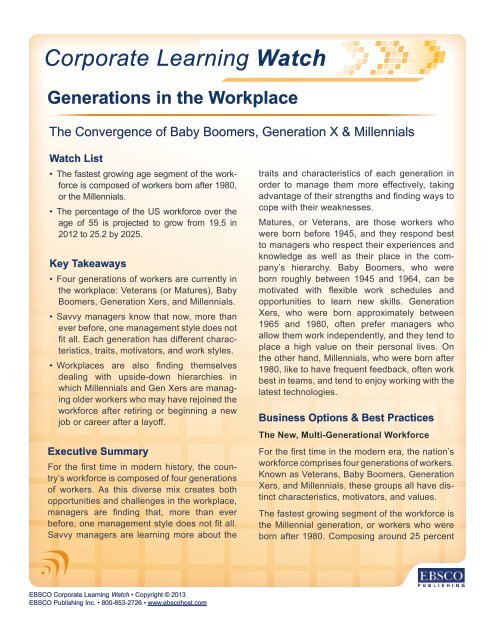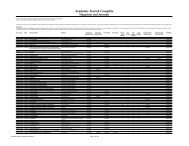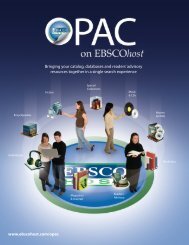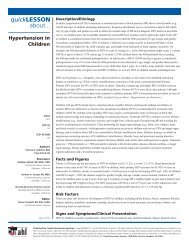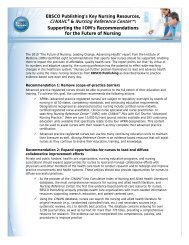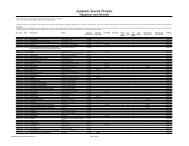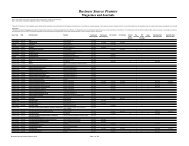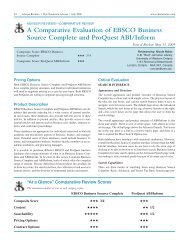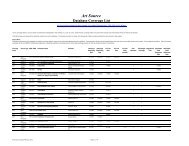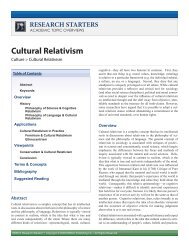Generations in the Workplace - EBSCO Publishing
Generations in the Workplace - EBSCO Publishing
Generations in the Workplace - EBSCO Publishing
You also want an ePaper? Increase the reach of your titles
YUMPU automatically turns print PDFs into web optimized ePapers that Google loves.
Corporate Learn<strong>in</strong>g Watch<br />
<strong>Generations</strong> <strong>in</strong> <strong>the</strong> <strong>Workplace</strong><br />
The Convergence of Baby Boomers, Generation X & Millennials<br />
Watch List<br />
• The fastest grow<strong>in</strong>g age segment of <strong>the</strong> workforce<br />
is composed of workers born after 1980,<br />
or <strong>the</strong> Millennials.<br />
• The percentage of <strong>the</strong> US workforce over <strong>the</strong><br />
age of 55 is projected to grow from 19.5 <strong>in</strong><br />
2012 to 25.2 by 2025.<br />
Key Takeaways<br />
• Four generations of workers are currently <strong>in</strong><br />
<strong>the</strong> workplace: Veterans (or Matures), Baby<br />
Boomers, Generation Xers, and Millennials.<br />
• Savvy managers know that now, more than<br />
ever before, one management style does not<br />
fit all. Each generation has different characteristics,<br />
traits, motivators, and work styles.<br />
• <strong>Workplace</strong>s are also f<strong>in</strong>d<strong>in</strong>g <strong>the</strong>mselves<br />
deal<strong>in</strong>g with upside-down hierarchies <strong>in</strong><br />
which Millennials and Gen Xers are manag<strong>in</strong>g<br />
older workers who may have rejo<strong>in</strong>ed <strong>the</strong><br />
workforce after retir<strong>in</strong>g or beg<strong>in</strong>n<strong>in</strong>g a new<br />
job or career after a layoff.<br />
Executive Summary<br />
For <strong>the</strong> first time <strong>in</strong> modern history, <strong>the</strong> country’s<br />
workforce is composed of four generations<br />
of workers. As this diverse mix creates both<br />
opportunities and challenges <strong>in</strong> <strong>the</strong> workplace,<br />
managers are f<strong>in</strong>d<strong>in</strong>g that, more than ever<br />
before, one management style does not fit all.<br />
Savvy managers are learn<strong>in</strong>g more about <strong>the</strong><br />
traits and characteristics of each generation <strong>in</strong><br />
order to manage <strong>the</strong>m more effectively, tak<strong>in</strong>g<br />
advantage of <strong>the</strong>ir strengths and f<strong>in</strong>d<strong>in</strong>g ways to<br />
cope with <strong>the</strong>ir weaknesses.<br />
Matures, or Veterans, are those workers who<br />
were born before 1945, and <strong>the</strong>y respond best<br />
to managers who respect <strong>the</strong>ir experiences and<br />
knowledge as well as <strong>the</strong>ir place <strong>in</strong> <strong>the</strong> company’s<br />
hierarchy. Baby Boomers, who were<br />
born roughly between 1945 and 1964, can be<br />
motivated with flexible work schedules and<br />
opportunities to learn new skills. Generation<br />
Xers, who were born approximately between<br />
1965 and 1980, often prefer managers who<br />
allow <strong>the</strong>m work <strong>in</strong>dependently, and <strong>the</strong>y tend to<br />
place a high value on <strong>the</strong>ir personal lives. On<br />
<strong>the</strong> o<strong>the</strong>r hand, Millennials, who were born after<br />
1980, like to have frequent feedback, often work<br />
best <strong>in</strong> teams, and tend to enjoy work<strong>in</strong>g with <strong>the</strong><br />
latest technologies.<br />
Bus<strong>in</strong>ess Options & Best Practices<br />
The New, Multi-Generational Workforce<br />
For <strong>the</strong> first time <strong>in</strong> <strong>the</strong> modern era, <strong>the</strong> nation’s<br />
workforce comprises four generations of workers.<br />
Known as Veterans, Baby Boomers, Generation<br />
Xers, and Millennials, <strong>the</strong>se groups all have dist<strong>in</strong>ct<br />
characteristics, motivators, and values.<br />
The fastest grow<strong>in</strong>g segment of <strong>the</strong> workforce is<br />
<strong>the</strong> Millennial generation, or workers who were<br />
born after 1980. Compos<strong>in</strong>g around 25 percent<br />
<strong>EBSCO</strong> Corporate Learn<strong>in</strong>g Watch • Copyright © 2013<br />
<strong>EBSCO</strong> Publish<strong>in</strong>g Inc. • 800-653-2726 • www.ebscohost.com
Corporate Learn<strong>in</strong>g Watch<br />
<strong>Generations</strong> <strong>in</strong> <strong>the</strong> <strong>Workplace</strong><br />
of <strong>the</strong> workforce today, it is expected to grow<br />
to reach 75 percent of <strong>the</strong> workforce by 2025<br />
(Dahwan, 2012). Meanwhile, <strong>the</strong> percentage of<br />
US workers over <strong>the</strong> age of 55 will grow from<br />
19.5 to 25.2 by 2020 (BLS, 2012).<br />
The large number of older workers is attributable<br />
to a number of causes. For one, <strong>the</strong> 2008<br />
recession depleted <strong>the</strong> retirement sav<strong>in</strong>gs of<br />
many Veterans and Baby Boomers, and <strong>the</strong>y<br />
are now f<strong>in</strong>d<strong>in</strong>g <strong>the</strong>mselves hav<strong>in</strong>g to delay or<br />
come out of retirement to make up <strong>the</strong> shortfall.<br />
O<strong>the</strong>r workers are f<strong>in</strong>d<strong>in</strong>g that <strong>the</strong>y did not<br />
save enough to retire <strong>in</strong> <strong>the</strong> first place. Second,<br />
advances <strong>in</strong> medic<strong>in</strong>e and healthcare have<br />
meant that many workers still feel active and<br />
productive enough to cont<strong>in</strong>ue work<strong>in</strong>g after<br />
65. These workers may also delay retirement,<br />
or <strong>the</strong>y may choose to beg<strong>in</strong> new careers on<br />
<strong>the</strong>ir own terms, perhaps by becom<strong>in</strong>g entrepreneurs.<br />
All of <strong>the</strong>se factors have created a new generational<br />
mix <strong>in</strong> <strong>the</strong> workplace. And because of<br />
each generation’s different characteristics, it can<br />
seem as if none of <strong>the</strong>m is speak<strong>in</strong>g <strong>the</strong> same<br />
language. All of this can lead to poor teamwork,<br />
low morale, and lost productivity. Fur<strong>the</strong>r, many<br />
workplaces are see<strong>in</strong>g new hierarchies as Millennials<br />
and Gen Xers manage Baby Boomers<br />
or Veterans who return to <strong>the</strong> workplace after a<br />
period of retirement or who beg<strong>in</strong> new jobs or<br />
careers after a lay off. This type of upside-down<br />
hierarchy can cause additional friction.<br />
On <strong>the</strong> o<strong>the</strong>r hand, <strong>the</strong> mix of generations <strong>in</strong><br />
<strong>the</strong> workplace can be a tremendous advantage.<br />
Mix<strong>in</strong>g Veterans’ experiences and knowledge<br />
with Millennials’ vitality, optimism, and technical<br />
savvy can greatly enhance corporate bottom<br />
l<strong>in</strong>es. However, <strong>in</strong> order capitalize on <strong>the</strong>se<br />
opportunities, managers must first learn to be<br />
“multil<strong>in</strong>gual,” speak<strong>in</strong>g <strong>the</strong> language of each<br />
generation, and f<strong>in</strong>d<strong>in</strong>g out what <strong>the</strong>y value,<br />
what motivates <strong>the</strong>m, and what <strong>the</strong>ir strengths<br />
and weaknesses are.<br />
Veterans<br />
Veterans (also referred to as Matures) were born<br />
before 1945, and as of 2010 <strong>the</strong>re were 75 million<br />
Veterans <strong>in</strong> <strong>the</strong> United States. Veterans did<br />
not typically go to college; <strong>in</strong>stead, <strong>the</strong>y began<br />
work<strong>in</strong>g immediately after high school or military<br />
service with <strong>the</strong> express <strong>in</strong>tent of f<strong>in</strong>d<strong>in</strong>g lucrative<br />
positions to support <strong>the</strong>ir families. Income<br />
from a stable, solid employer, not necessarily<br />
personal fulfillment, was <strong>the</strong> driv<strong>in</strong>g force of<br />
most Veterans. They came of age <strong>in</strong> an era <strong>in</strong><br />
which it was typical for a person to work for a<br />
s<strong>in</strong>gle company until retirement. Loyalty to <strong>the</strong>ir<br />
companies is a prime value for Veterans. This<br />
generation respects <strong>the</strong> cha<strong>in</strong> of command, <strong>the</strong>y<br />
value experience <strong>in</strong> o<strong>the</strong>rs and <strong>in</strong> <strong>the</strong>mselves,<br />
and <strong>the</strong>y appreciate dedication, loyalty, and<br />
hard work.<br />
Managers of Veterans are most effective when<br />
<strong>the</strong>y:<br />
• Respect <strong>the</strong>m for <strong>the</strong>ir experiences, knowledge,<br />
and know-how.<br />
• Motivate <strong>the</strong>m with extra benefits, like an<br />
<strong>in</strong>crease <strong>in</strong> health <strong>in</strong>surance.<br />
• Respect <strong>the</strong>ir place <strong>in</strong> <strong>the</strong> company’s hierarchy<br />
and <strong>the</strong> cha<strong>in</strong> of command.<br />
• Value politeness and punctuality.<br />
Baby Boomers<br />
Baby Boomers were born between 1946 and<br />
1964, and <strong>the</strong>y totaled 80 million people <strong>in</strong> <strong>the</strong><br />
US <strong>in</strong> 2010. Their youth was marked by a period<br />
<strong>EBSCO</strong> Corporate Learn<strong>in</strong>g Watch • Copyright © 2013<br />
<strong>EBSCO</strong> Publish<strong>in</strong>g Inc. • 800-653-2726 • www.ebscohost.com<br />
2
Corporate Learn<strong>in</strong>g Watch<br />
<strong>Generations</strong> <strong>in</strong> <strong>the</strong> <strong>Workplace</strong><br />
of national unrest, and this created a strong<br />
sense of <strong>in</strong>dividualism. As <strong>the</strong> Boomers matured<br />
dur<strong>in</strong>g <strong>the</strong> late 1970s and 1980s, <strong>the</strong>y became<br />
known for prioritiz<strong>in</strong>g <strong>the</strong>ir careers and experienc<strong>in</strong>g<br />
a high degree of stress <strong>in</strong> <strong>the</strong>ir personal<br />
lives as a result. Their children were <strong>the</strong> first<br />
generation of “latch-key kids” who had two parents<br />
work<strong>in</strong>g outside <strong>the</strong> home.<br />
Boomers tend to value personal connections<br />
amongst coworkers, put a lot of time and effort<br />
<strong>in</strong>to <strong>the</strong>ir work, and expect <strong>the</strong>ir subord<strong>in</strong>ates to<br />
do <strong>the</strong> same. Unlike Veterans, Boomers are not<br />
opposed to job-hopp<strong>in</strong>g if it serves <strong>the</strong>ir <strong>in</strong>terests.<br />
Mangers of Boomers will do well to:<br />
• Motivate <strong>the</strong>m with flexible work schedules and<br />
extra time off to care for children and ag<strong>in</strong>g<br />
parents.<br />
• Offer <strong>the</strong>m opportunities to learn new skills and<br />
add to <strong>the</strong>ir personal marketability.<br />
• Encourage <strong>the</strong>m to work collaboratively and<br />
talk problems through with coworkers.<br />
Generation X<br />
Generation X, born between 1965 and 1980,<br />
totaled 46 million people <strong>in</strong> <strong>the</strong> United States <strong>in</strong><br />
2010. As <strong>the</strong>ir Baby Boomer mo<strong>the</strong>rs <strong>in</strong>creas<strong>in</strong>gly<br />
entered <strong>the</strong> workforce, Generation X<br />
became <strong>the</strong> first generation <strong>in</strong> which a significant<br />
number of children grew up <strong>in</strong> dual-<strong>in</strong>come<br />
households. They were also <strong>the</strong> first generation<br />
of “latch-key” kids. They learned to be <strong>in</strong>dependent,<br />
self-reliant, resourceful, and comfortable<br />
on <strong>the</strong>ir own. In <strong>the</strong> workplace, Gen Xers are<br />
<strong>in</strong>dependent, technologically savvy, and strong<br />
multi-taskers. As a rule, <strong>the</strong>y do not see <strong>the</strong><br />
value <strong>in</strong> frequent meet<strong>in</strong>gs when a weekly, or<br />
even daily, email update can provide <strong>the</strong> same<br />
<strong>in</strong>formation. This generation is motivated by<br />
extra time off ra<strong>the</strong>r than money, and <strong>the</strong>y place<br />
a high value on <strong>the</strong>ir personal lives. Many Gen<br />
X women are choos<strong>in</strong>g to leave high-powered<br />
careers to focus on <strong>the</strong>ir families.<br />
Managers of Gen Xers can work with <strong>the</strong>m<br />
effectively by:<br />
• Offer<strong>in</strong>g <strong>the</strong>m opportunities to work <strong>in</strong>dependently<br />
and multitask.<br />
• Not requir<strong>in</strong>g <strong>the</strong>m to attend too many meet<strong>in</strong>gs.<br />
• Offer<strong>in</strong>g <strong>the</strong>m guidel<strong>in</strong>es for <strong>the</strong>ir work ra<strong>the</strong>r<br />
than micromanag<strong>in</strong>g <strong>the</strong>m.<br />
• Recogniz<strong>in</strong>g that <strong>the</strong>y appreciate candor and<br />
deliver<strong>in</strong>g any criticism pla<strong>in</strong>ly and directly.<br />
Millennials<br />
Millennials, or Generation Y, born after 1980,<br />
totaled 76 million people <strong>in</strong> <strong>the</strong> United States <strong>in</strong><br />
2010. This era saw <strong>the</strong> return to child-centered<br />
households as many late Boomers and early<br />
Gen Xers chose to focus on family ra<strong>the</strong>r than<br />
<strong>the</strong>ir careers. Many Millennials’ have relationships<br />
with <strong>the</strong>ir parents that are characterized<br />
by friendship, and because of this <strong>the</strong>y expect<br />
to be treated as equals <strong>in</strong> <strong>the</strong> workplace. Millennials<br />
are <strong>the</strong> most technologically savvy<br />
generation <strong>in</strong> <strong>the</strong> workplace, hav<strong>in</strong>g grown up<br />
with much of <strong>the</strong> technology that fills <strong>the</strong> modern<br />
workplace.<br />
They tend to need more feedback, more frequently<br />
than <strong>the</strong>ir Gen X predecessors, and<br />
<strong>the</strong>y often need tasks carefully outl<strong>in</strong>ed. They<br />
often prefer to work <strong>in</strong> teams and are highly<br />
adaptable.<br />
Mangers can best work with Millennials by:<br />
• Giv<strong>in</strong>g <strong>the</strong>m frequent feedback about <strong>the</strong>ir<br />
work, both positive and negative.<br />
<strong>EBSCO</strong> Corporate Learn<strong>in</strong>g Watch • Copyright © 2013<br />
<strong>EBSCO</strong> Publish<strong>in</strong>g Inc. • 800-653-2726 • www.ebscohost.com<br />
3
Corporate Learn<strong>in</strong>g Watch<br />
<strong>Generations</strong> <strong>in</strong> <strong>the</strong> <strong>Workplace</strong><br />
• Provid<strong>in</strong>g <strong>the</strong>m with detailed <strong>in</strong>structions for<br />
tasks.<br />
• Remember<strong>in</strong>g that Millennials tend to value<br />
<strong>the</strong>ir personal lives more than <strong>the</strong>ir jobs and<br />
that, unlike Boomers, <strong>the</strong>y have no trouble lett<strong>in</strong>g<br />
<strong>the</strong>ir bosses know this.<br />
• Tak<strong>in</strong>g advantage of how much <strong>the</strong>y value <strong>the</strong>ir<br />
parents’ wisdom and experience by match<strong>in</strong>g<br />
<strong>the</strong>m with older, experienced mentors.<br />
• Mak<strong>in</strong>g sure <strong>the</strong>y have <strong>the</strong> opportunity to work<br />
with <strong>the</strong> latest technology.<br />
Fur<strong>the</strong>r Read<strong>in</strong>g<br />
Bureau of Labor Statistics. (2012). Labor force<br />
projections to 2020: A more slowly grow<strong>in</strong>g<br />
workforce. Bureau of Labor Statistics.<br />
Retrieved April 15, 2013 from http://www.bls.<br />
gov/opub/mlr/2012/01/art3full.pdf<br />
Dahwan, E. (2012, January 23). Generation-<br />
Y workforce and workplace are out of sync.<br />
Forbes. Retrieved April 15, 2013 from http://<br />
www.forbes.com/sites/85broads/2012/01/23/<br />
gen-y-workforce-and-workplace-are-out-ofsync/<br />
Ruch, W. (2005). Full engagement. Leadership<br />
Excellence, 22(12), 11. Retrieved April 16,<br />
2010, from <strong>EBSCO</strong> Onl<strong>in</strong>e Database Bus<strong>in</strong>ess<br />
Source Complete. http://search.ebscohost.<br />
com/log<strong>in</strong>.asp x?direct=true&db=bth&AN=195<br />
93386&site=ehost-live<br />
Sowa, A. (2006). Connect<strong>in</strong>g workers from different<br />
generations essential, workplace expert<br />
says. Bullet<strong>in</strong>, The (Bend, OR). Retrieved<br />
April 16, 2010, from <strong>EBSCO</strong> Onl<strong>in</strong>e Database<br />
Newspaper Source Plus. http://search.ebscohost.com/log<strong>in</strong>.aspx?direct=true&db=n5h&AN<br />
=2W62W61835016495&site =ehost-live<br />
Uncerta<strong>in</strong> economy beats Gen Y <strong>in</strong>to shape:<br />
Survey. (2010, March 17). CIO (13284045),<br />
1. Retrieved April 16, 2010, from <strong>EBSCO</strong><br />
Onl<strong>in</strong>e Database Bus<strong>in</strong>ess Source Complete.<br />
http://search.ebscohost. com/<br />
log<strong>in</strong>.aspx?direct=true&db=bth&AN=48<br />
734183&site=ehost-live<br />
<strong>EBSCO</strong> Corporate Learn<strong>in</strong>g Watch • Copyright © 2013<br />
<strong>EBSCO</strong> Publish<strong>in</strong>g Inc. • 800-653-2726 • www.ebscohost.com<br />
4


